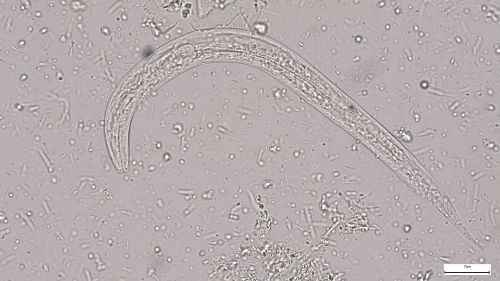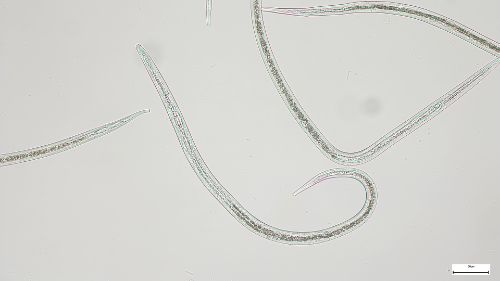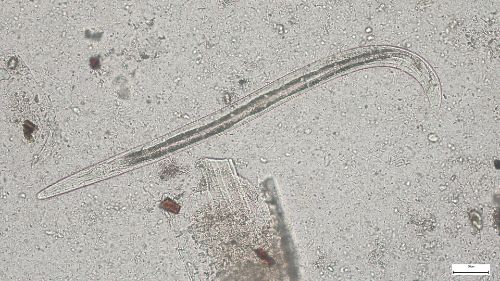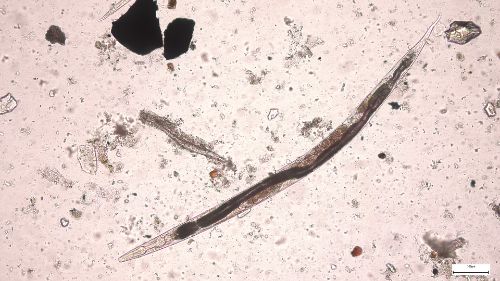Introduction to Diagnostic Medical Parasitology
Strongyloides stercoralis
Strongyloides stercoralis first-stage rhabditiform (L1) larvae

Rhabditiform larvae of Strongyloides stercoralis can be detected in stool samples, as the eggs undergo embryonation and hatch within the mucosa of the small intestine of the host. These larvae may also be present in the soil and cultured feces.
The first-stage rhabditiform larvae (L1) of Strongyloides stercoralis measure 180—380 µm in length. They feature a short buccal canal, a rhabditoid esophagus divided into three sections, extending about one-third of the body length, and a prominent genital primordium.
In comparison, the second-stage rhabditiform larvae (L2) are longer than the L1 larvae and have a smaller esophagus/intestine ratio. These L2 larvae are a more advanced developmental stage of the parasite as they continue their life cycle outside the host's body.
Strongyloides stercoralis third-stage filariform (L3) larvae


Infective, third-stage filariform larvae (L3) of Strongyloides stercoralis can reach lengths of up to 600 µm. They are characterized by a notched tail and an esophagus-to-intestine ratio of 1:1, which differentiates them from the filariform larvae of hookworms. Hookworm filariform larvae have a short esophagus and a pointed tail.
These infective L3 larvae of Strongyloides stercoralis are commonly found in the soil. They enter the human host by directly penetrating the skin, typically through bare feet when walking on contaminated soil. This skin-penetrating mechanism is known as dermal or cutaneous larva migrans.
Additionally, Strongyloides stercoralis can exhibit autoinfection, wherein the larvae produced by the adult female worms within the host's intestines can invade the intestinal mucosa, enter the bloodstream, and then migrate to the respiratory tract. As a result, infective L3 larvae may be found in respiratory specimens during cases of autoinfection, contributing to the complexity of the parasite's life cycle.
Adult Strongyloides stercoralis

Strongyloides stercoralis adult worms can be found in both the human host and the soil. Parasitic males of Strongyloides stercoralis do not exist, meaning that the adult male form is not found in the parasitic stage of the life cycle. However, parasitic females are present, and they are characterized as long and slender, measuring approximately 2.0—3.0 mm in length.
Free-living adult males of Strongyloides stercoralis can grow up to 0.75 mm in length, while free-living females can reach lengths of up to 1.0 mm. These free-living adult forms are found in the soil and play a role in the life cycle of the parasite outside of the human host.